Marc Abrahams's Blog, page 274
April 18, 2016
Introducing the “Visual Muzzle” (new patent)
A new patent from inventor Yee Chong Leung of Shatin, Hong Kong provides a warm cap for a pet (say, for example a dog) – but its key feature is that it also operates as an electronic ‘Visual Muzzle’.
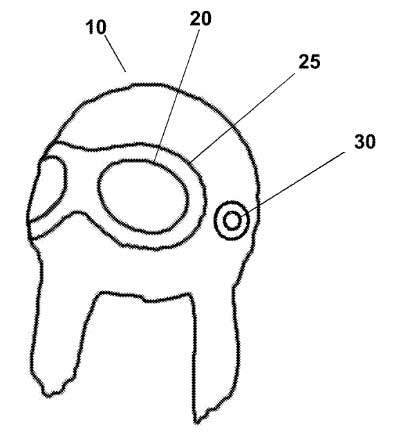 Wearing the cap, the pet is obliged to look though goggles made of smart glass or plastic which can instantly turn opaque when electronically activated. The helmet also incorporates a camera system linked to an image processor which is programmed to identify (in real time) living creatures which could be possible victims of a dog attack. If the system detects a potential victim nearby, the goggles immediately become opaque – “such that the pet is temporarily impaired from seeing anything.“
Wearing the cap, the pet is obliged to look though goggles made of smart glass or plastic which can instantly turn opaque when electronically activated. The helmet also incorporates a camera system linked to an image processor which is programmed to identify (in real time) living creatures which could be possible victims of a dog attack. If the system detects a potential victim nearby, the goggles immediately become opaque – “such that the pet is temporarily impaired from seeing anything.“
See: ‘Warm cap with security features’ US patent granted Mar. 8th 2016.
Question [optional] The invention is primarily intended to protect humans from aggressive dogs – could the invention be scaled up and adapted to protect humans from each other?

April 17, 2016
An Informative Title: An Optional Subtitle (and all the rest)
If you are a human or robot who or that wishes to interact, in a literary way, with other humans or robots, you may begin by drawing a blank. Someone or something has anticipated your situation, and prepared a literary document that may or may not be helpful. This is how that document begins:
An Informative Title: An Optional Subtitle
First Author, Another Author
First Affiliation
and
Someone Else
Second Affiliation
Use as many key words as possible in your abstract. Limit its length to 960 characters. For
an empirical study, use 100 to 120 words to describe the problem, participants, method,
findings, and conclusions. For a theoretical or review article, use 75 to 100 words to state
the article’s topic, thesis, scope, sources, and conclusions. Define all abbreviations and
unique terms. Spell out names of tests and technologies. Use paraphrases, not quotations.
Keywords: Human-robot interaction, recognition, sensors, emotions
1. Introduction
This article is a description of how to create a document of the appropriate style for a
submission to the Journal of Human-Robot Interaction (JHRI)….
You can download the entire paper and do what you like with it, within reason (and of course within the limits of reality).

April 16, 2016
When drone met pork
A project at Aalborg University, in Denmark, observed what happens when a drone’s whirling propeller collides with a hunk of pork. This video captures the collision, showing it in slowed-down motion:
Kelsey D. Atherton wrote about this, for Popular Science magazine.
BONUS: Here’s video of an unplanned experiment, by a different research team, with a drone propeller and a human hand:

April 15, 2016
‘Reversed Paintings’ (Possibilizations for Thing-Theorists)
Before considering the history and implications of reversed paintings, we need a definition – and we have one provided by Richard Read, who is Winthrop Professor in Art History at the University of Western Australia.
“I define the reversed painting as a painting of a painting reversed against the spectator.”
Professor Read is writing in Transformations : Journal of Media & Culture (2016, No. 27). His paper, ‘Possibilization and Desuetude: the Politics of the Reversed Canvas as Thing-Object’ not only provides visual examples [the artwork below is Cornelius Norbertus Gijsbrechts’, Trompe l’oeil. The Reverse of a Framed Painting, 1670, oil on canvas, Statens Museum for Kunst, Copenhagen]
– but also informs, for example, that:
“ Where paintings are concerned, the visibility of their fronts and backs are vivid markers of their transition between phases of commodification, display and desuetude. This is why, as representations, backs of paintings lend themselves to it-narratives that existed far earlier than those eighteenth-century literary biographies of things of which James Lamb and others wrote.”
The professor also alerts us to the idea that paintings (and other framed art) can, in a sense, be “switched on” or “switched off” – by flipping their direction towards or away from the viewer.
Also see: Empty Photographic Frames : Punctuating the Narrative

April 14, 2016
High Altitude Flatus Expulsion (a.k.a. Rocky Mountain Barking Spiders)
One of the side effects of venturing to high altitudes (or any environment where the air pressure is lower than normal, say, for example inside a passenger airplane at cruising height) is an increase in the expellation of intestinal gases. As a number of our readers will no doubt be aware, the syndrome was first [?] pinpointed in the book : Beschreibung zweyer Reisen auf den Montblanc, unternommen im August 1820 mit einer Ansicht des Montblanc und einer Karte des Chamounythals und seiner Umgebung by Iosif Gamel [or poss. Joseph Hamel] c. 1820.
The book, in examining possible medical effects of climbing Mont Blanc, describes various unpleasant experiments featuring animals under evacuated bell-jars – and the various gases which were expelled. But perhaps less well known is that in 1981 the issue was brought up to date by Paul S. Auerbach, MD, MS, FACEP, FAWM, (now Redlich Family Professor of Surgery in the Division of Emergency Medicine at Stanford University) and York E. Miller, MD (now Professor of Medicine at the University of Colorado, Denver). The condition was given the modern acronym – HAFE – in their letter to the editor of the Western Journal of Medicine, 1981 February; 134(2): 173–174 ‘High Altitude Flatus Expulsion.’
“The syndrome is strictly associated with ascent, and is characterized by an increase in both the volume and the frequency of the passage of flatus, which spontaneously occurs while climbing to altitudes of 11,000 feet or greater.”
They note that it’s also known (presumably by those outside the medical establishment, e.g. mountaineering enthusiasts) as ‘Rocky Mountain Barking Spiders’.

Observer’s report on the Ig Nobel show in Lausanne
The Why How How blog published this report about the recent Ig Nobel show at EPFL in Lausanne, Switzerland. We re-publish it here with permission — machine-translated from the original French:
Ig Nobel Award Tour Show
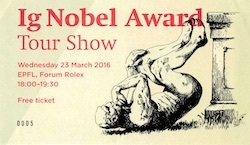 As some still do not know the famous Ig Nobel Prize. Their founder Marc Abrahams travels the world to present this institution. I had the chance to attend the “Ig Nobel Award Tour Show” organized at EPFL few weeks ago, and it was a great moment of hair-raising science.
As some still do not know the famous Ig Nobel Prize. Their founder Marc Abrahams travels the world to present this institution. I had the chance to attend the “Ig Nobel Award Tour Show” organized at EPFL few weeks ago, and it was a great moment of hair-raising science.
The “Show” takes place in two stages. First, Marc Abrahams explains the purpose of prize:
Reward research that makes you laugh, then think
Then he describes the selection mechanism, award ceremony and the famous award prizes to Harvard, to which I give a lot to attend. Meanwhile, the latter is video here. Excellent communicator and tongue-in-cheek, Marc Abrahams illustrates his point with many examples and hilarious documents, all in perfectly understandable English. This part of the evening is much like its visible TED conference in video here.
Secondly, the Ig Nobel past winners present their award-winning works. We had 3 presentations:
Emily Baird of Lund University explained how it determined that “The dung beetle uses the Milky Way for orientation “[1], which earned him the 2013 Prize for biology and astronomy.
In fact, his team demonstrated that this beetle does not mark is the surrounding landscape to move away online the right of a good steaming dung with a small ball of dung appetizing, but it keeps a constant angle relative to the most intense light source: Sun day, moon night, or failing that, the Milky Way, good light in the nights of the southern African savannas.
Then Elisabeth Oberzaucher of the University of Vienna, winner of the 2015 math Prize calculated “How Moulay Ismail bin Sharif Sultan of Morocco, could generate 888 children? “[2] Now, a harem of 500 women it helps, but despite that, given the relatively random nature of female fertility, Sultan also has the unsavory give himself …
Finally Stephan Bolliger of the University of Zurich responded to the question “Is it better to be smashed his head with a full bottle of beer or empty? “[3] which earned him the 2009 Peace Prize. According to the tests, the two cases are likely to cause a skull fracture, but it takes more force to break up an empty bottle full …
With the latter prize my beautiful country won the IgNobel Peace Prize for two consecutive years since 2008 our Federal Ethics Commission had already been awarded to an official document on the dignity of plants. The little interlude where Marc Abrahams congratulated one by one all the Swiss citizens of the co-recipients of the award assistance was illustrated by this splendid slide quoting the award-winning report [4]:
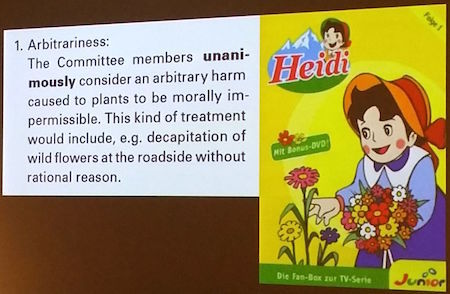
Excellent evening so I urge you to attend a “IgNobel Award Tour Show” near you (or organize one …). We start with much laughing, but also thinking.
References
(For the record, I contribute to maintain a list of publications’s award IgNobel on Mendeley )
Mr. Dacke, E. Baird, Mr. Byrne, CH Scholtz, and EJ Warrant, “Dung beetles use the Milky Way for orientation” Curr. Biol., Vol. 23, no. 4, pp. 298-300, Feb. 2013. doi: 10.1016 / j.cub.2012.12.034
Oberzaucher E. and K. Grammer, “The Case of Moulay Ismael – Fact or Fancy ?,” PLoS One, vol. 9, no.2, p. e85292, Feb. 2014. doi: 10.1371 / journal.pone.0085292
Bolliger SA, S. Ross, L. Oesterhelweg, MJ Thali, and BP Kneubuehl, “Are full or empty beer bottles sturdier and Does Their fracture-threshold suffice to break the human skull ?,” J. Forensic Leg. Med., Vol. 16, no. 3, pp. 138-42, Apr. 2009. DOI: 10.1016 / j.jflm.2008.07.013
Federal Ethics Committee on Non-Human Biotechnology (ECNH) ” The Dignity of Living Beings with regard to plants” 2008 Bern, Switzerland

Analyzing Why Bearcats Smell Like Popcorn
A new study adds to our knowledge of why some animals sometimes smell like buttered popcorn. The study is:
“Reproductive Endocrine Patterns and Volatile Urinary Compounds of Arctictis binturong: Discovering Why Bearcats Smell Like Popcorn,” Lydia K. Greene [pictured below], Timothy W. Wallen, Anneke Moresco, Thomas E. Goodwin, Christine M. Drea, The Science of Nature, vol. 103, June 2016, 37. The authors, at Duke University and other institutions, explain:
Members of the order Carnivora rely on urinary scent signaling, particularly for communicating about reproductive parameters. Here, we describe reproductive endocrine patterns in relation to urinary olfactory cues in a vulnerable and relatively unknown viverrid—the binturong (Arctictis binturong).
(Thanks to Tony Tweedale for bringing this to our attention.)

We live in the Era of Billionaire-Scientifical-Superheroes
We are fortunate* to live in the Era of Billionaire-Scientifical-Superheroes. Here are recent press reports about a five of them.
 “Cure Baldness? Heal Arthritis? Erase Wrinkles? An Unknown Billionaire’s Quest To Reverse Aging [reported in Forbes magazine. the photo here is from that report]
“Cure Baldness? Heal Arthritis? Erase Wrinkles? An Unknown Billionaire’s Quest To Reverse Aging [reported in Forbes magazine. the photo here is from that report]“$250 million, 300 scientists and 40 labs: Sean Parker’s revolutionary project to ‘solve’ cancer” [reported in the Washington Post]
“Stephen Hawking and a Russian Billionaire Want to Build an Interstellar Starship” [reported in Gizmoto]
“This Woman’s Revolutionary Idea Made Her A Billionaire — And Could Change Medicine” [reported in Business Insider]
“Can Billionaire Robert Bigelow Create a Life for Humans in Space?” [reported in Popular Science]
As in many walks of life, there is a dramatic gender imbalance in this emerging field. The Billionaire Scientifical-Superheroes gender imbalance may be growing worse (see “Regulators Propose Banning Theranos Founder Elizabeth Holmes for at Least Two Years“, reported in the Wall Street Journal).
(*Some analysts argue that we are fortunate to live at all.)

April 13, 2016
Standardized food glops [podcast 59]
Food glops that are standardized — that’s what dominates this week’s Improbable Research podcast.
SUBSCRIBE on Play.it, iTunes, or Spotify to get a new episode every week, free.
This week, Marc Abrahams —with dramatic readings by Nicole Sharp — tells about:
Standardized food glops (1) — National Institute of Standards and Technology (2009). ‘Certificate of Analysis – Standard Reference Material 1548A: Typical Diet’.
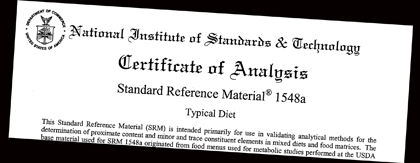
Standardized food glops (2) — Sharpless, Katherine E., Jennifer C. Colbert, Robert R. Greenberg, Michele M. Schantz, and Michael J. Welch (2001). ‘Recent Developments in Food-Matrix Reference Materials at NIST.’ Fresenius Journal of Analytic Chemistry 370: 275–78..
Business lessons from The Wizard of Oz — “Impaired Employees: Lessons Learned from The Wonderful Wizard of Oz,” Michael Harvey, Miriam Moellera, Hugh Sloan III and Alex Williams, Business Horizons, vol. 53, no. 6, November-December 2010, Pages 561-570.
The mysterious John Schedler or the shadowy Bruce Petschek perhaps did the sound engineering this week.
The Improbable Research podcast is all about research that makes people LAUGH, then THINK — real research, about anything and everything, from everywhere —research that may be good or bad, important or trivial, valuable or worthless. CBS distributes it, on the CBS Play.it web site, and on iTunes and Spotify).

April 12, 2016
Taxonomists squabble, but Okamura baffles them
Taxonomists may squabble and quibble (as a recent article called “Why Do Taxonomists Write the Meanest Obituaries?” makes clear), but most taxonomists are baffled by the works produced by the late Chonosuke Okamura, discoverer of the mini-creatures.
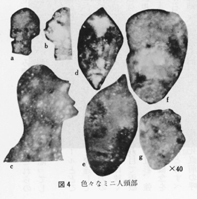 Here is a set of photographic images from one of Okamura’s books. These, say Okamura, are faces of several minimen.
Here is a set of photographic images from one of Okamura’s books. These, say Okamura, are faces of several minimen.
Okamura was posthumously awarded an Ig Nobel Prize in the field of biodiversity, in 1996, for discovering the fossils of dinosaurs, horses, dragons, princesses, and more than 1000 other extinct “mini-species,” each of which is less than 1/100 of an inch in length.

Marc Abrahams's Blog
- Marc Abrahams's profile
- 14 followers






